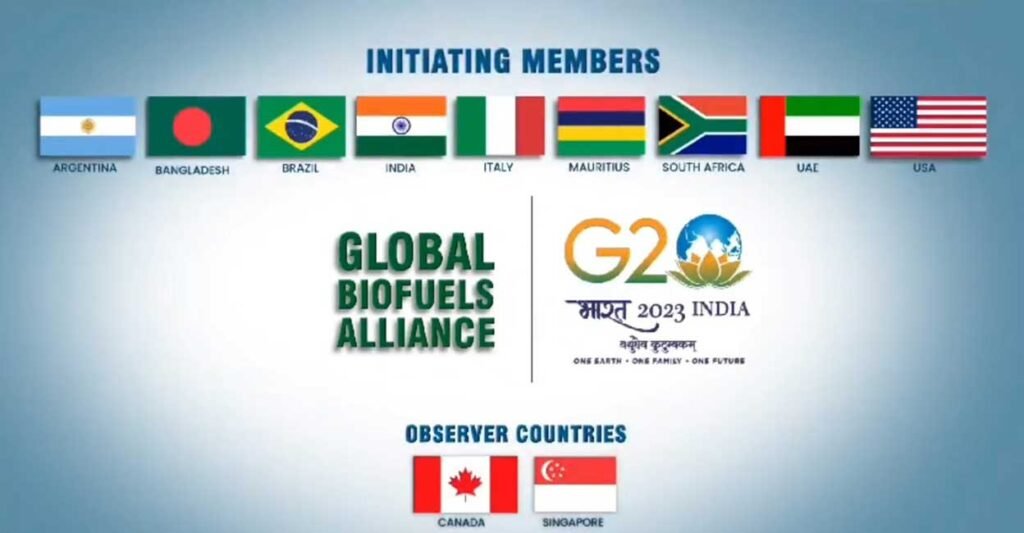
After Indian Petroleum Sector Reforms, India today, have one of the lowest fuel prices, and this is the only country where prices have decreased in the last 2.5-3 years. said Minister of Petroleum & Natural Gas, Shri Hardeep Singh Puri.
Some may find this statement by our union minister to be a square peg in a round hole statement by some critics who call it a misfit in the context of the Indian common man who often complain about exorbitant prices of fuel.
India, a net importer of crude oil, plays a pivotal role in global oil markets. As energy transitions accelerate and China’s economy shifts toward a less energy-intensive phase, India emerges as the world’s largest oil market with a demand growth this decade. However, this growth comes with challenges and implications.
With nearly 80% of its oil requirements imported, any meaningful rise in Brent oil prices and global Geopolitical tensions, with supply disruptions affect the nation’s economic stability and energy security.
At the same time, India’s commitment to net-zero emissions by 2070 which aligns with the Paris Agreement’s target of limiting global warming to 1.5°C. Structural changes in the energy sector are essential to achieve these goals which further increase the cost of energy. India is transitioning to cleaner energy sources while ensuring energy security for the population of 1.5 billion.
Let’s have a comprehensive overview of the status of energy market needs and the steps taken by the Indian government for Indian Petroleum Sector Reforms of late to address the key problems of the energy market, reducing import bills in synchronous with climate commitments pledged by India.
Table of Contents
Indian Petroleum Sector Reforms through Petrol and Diesel deregulation
The one of the biggest Indian Petroleum Sector Reforms was deregulation of petrol and diesel prices occurred in 2010 and 2014. the deregulation implies that fuel prices are determined by the oil marketing companies rather than being set by the government. This not only paved the way for lower market-driven prices but also improved the financial health of Indian oil companies and built the trust in Indian economy.
Additionally, the government has reduced excise duties on many occasions, which lowered the prices of petrol and diesel in retail market
Expansion of Refining and Storage capacity
With the gradual expansion of refining capacity, the country has already become self-sufficient in the refining sector. The refineries are continuously upgrading their facilities with the latest technologies to improve refining quality. As a result of various efforts, Indian refining capacity has increased from 215.1Million Metric Tonne Per Annum (MMTPA) to 256.8 MMTPA in last 10 years.
Indian Petroleum Sector Reforms have increased the domestic consumption of petroleum products in the year 2023-24 was 233.3 MMTPA which made Indian oil refining companies to export the surplus refined petroleum product. The country’s refining capacity is projected to increase to 309.5 MMTPA by 2028.
India has strategically established three underground Strategic Petroleum Reserves (SPRs) to enhance energy security and mitigate supply disruptions. These SPRs are located as follows:
- Visakhapatnam, Andhra Pradesh: This facility has a storage capacity of 1.33 million metric tonnes (MMT) of crude oil.
- Mangaluru, Karnataka: The Mangalore SPR can store up to 1.5 MMT of crude oil.
- Padur, Karnataka (Udupi district): Padur’s underground caverns provide a storage capacity of 2.5 MMT of crude oil.
Reduce Import of Crude Oil
The government has taken various steps to reduce the import of crude oil. These efforts for Indian Petroleum Sector Reforms include demand substitution by promoting the usage of natural gas as fuel/feedstock across the country towards increasing the share of natural gas in the economy and moving towards gas-based economy, promotion of renewable and alternate fuels like second-generation ethanol, compressed biogas, and biodiesel.
Refinery process improvements, promoting energy efficiency and conservation, efforts for increasing production of oil and natural gas through various policy initiatives, etc. To give a major thrust to the Ethanol Blending Program, the Government of India through Oil Marketing Companies (OMCs) is establishing 2G Ethanol plants across the country.
Also, to promote the use of Compressed Biogas (CBG) as automotive fuel, the Sustainable Alternative Towards Affordable Transportation (SATAT) initiative has been launched. Its objective is to set up Compressed Biogas (CBG) production plants and make CBG available for market use in automotive and industrial applications.
To materialize Indian Petroleum Sector Reforms the government has been taking various steps to increase hydrocarbon production which include Natural Gas Marketing Reforms, 2020.
Energy Efficient Initiatives
Based on the long-term growth trends in the consumption of Petrol and Diesel Government has made several efforts towards energy transition for Indian Petroleum Sector Reforms, some of them are
increasing the adoption of Compressed Natural Gas (CNG),
increase the usage of Biofuels including Ethanol,
focusing on Electric Vehicles (EV),
Implementing BS-VI standards for Indian vehicles with effect from 01.04.2020 and Distribution of BS-VI Auto Fuel

Hydrogen fuel adoption etc.
Ethanol blending
Since the Prime Minister’s announcement on E20 (20% ethanol blended fuel) in 2023, the E20 availability has increased to 12,000 outlets in under a year, By Indian Petroleum Sector Reforms we are close to achieving the target of 20% ethanol blending by 2025-26.
During the last 10 years these ethanol blending initiatives have enhanced farmer incomes, increased rural employment, reduced CO2 emissions equivalent to planting 1.75 crore trees and resulted in savings of Rs 85,000 crore worth of foreign exchange.
The number of retail outlets retailing E20 is now more than 9300 and will cover the entire country by 2025.
Pradhan Mantri JI-VAN
Under the agenda to manifest Indian Petroleum Sector Reforms the government has notified the “Pradhan Mantri JI-VAN (Jaiv Indhan- Vatavaran Anukool fasal awashesh Nivaran) Yojana” for providing financial support for setting up Second Generation (2G) bioethanol projects in the country to encourage the establishment of 2G bio-ethanol plant using cellulosic and lignocellulosic biomass including petrochemical route and other feedstocks.
Under this scheme, six commercial 2G bio-ethanol plants and four demonstration 2G bio-ethanol plants have been approved.
The 2G bio-ethanol plant set up by IOCL at Panipat, Haryana has been dedicated to the Nation on 10th August, 2022. The commercial bio-ethanol plants at Bathinda, Bargarh and Numaligarh are in advanced stages of construction.
IOCL has also set up a Third-Generation bio-ethanol plant at Panipat, Haryana.
The OMCs have signed long-term offtake agreements with 131 dedicated ethanol plants. These plants are expected to add an annual production design capacity of 745 crore litres. OMCs have also invested in increasing storage capacity and allied infrastructure for handling higher blending percentages.
The transition of high-volume vehicles to alternative fuels is a testament to India’s commitment to the climate target of decarbonization.
ETHANOL 100
One of the key milestone in Indian Petroleum Sector Reforms is the launch of ‘ETHANOL 100, a revolutionary automotive fuel at Indian Oil Retail Outlets. Through this initiative, India is now among the few countries in the world to have ETHANOL 100 fuel, Indian consumers can avail ETHANOL 100 at select 183 retail outlets across five states – Maharashtra, Karnataka, Uttar Pradesh, New Delhi, and Tamil Nadu.
The ETHANOL 100 is a revolutionary fuel that has the potential to transform our transportation sector and reduce our dependence on fossil fuels. It reflects the government’s commitment to reducing import dependency, conserving foreign exchange, and boosting the agriculture sector.
ETHANOL 100 stands as a cleaner, greener alternative to gasoline, boasting lower emissions of greenhouse gases and pollutants, thus aiding in combating climate change and enhancing air quality in our communities. With its high-octane rating, typically between 100-105, ETHANOL100 proves ideal for high-performance engines, ensuring improved efficiency and power output all while minimizing environmental impact.
ETHANOL 100’s versatility shines through, as it can be used in a wide array of vehicles, including flex-fuel vehicles (FFVs) designed to run on gasoline, ethanol, or any blend of the two, showcasing its practicality and potential to become a mainstream fuel option with the right infrastructure in place.
CBG blending Obligation (CBO)
The CBG Blending Obligation (CBO) is a policy introduced by the Indian government for Indian Petroleum Sector Reforms to promote the production and consumption of Compressed Biogas (CBG) in the country.
The CBO aims to stimulate demand for CBG in the City Gas Distribution (CGD) sector, reduce reliance on imported Liquefied Natural Gas (LNG), save foreign exchange reserves, promote circular economy practices, and contribute to achieving net-zero emissions.
Voluntary Phase (till FY 2024-2025): During this period, blending CBG with Compressed Natural Gas (CNG) and Piped Natural Gas (PNG) remains voluntary.
Mandatory Phase (from FY 2025-26): Starting from FY 2025-26, blending CBG becomes mandatory.
- FY 2025-26: Blending 1% of total CNG/PNG consumption.
- FY 2026-27: Blending 3% of total CNG/PNG consumption.
- FY 2027-28: Blending 4% of total CNG/PNG consumption.
- From FY 2028-29 onwards: Blending 5% of total CNG/PNG consumption.
By encouraging CBG adoption, the CBO aims to enhance energy security, reduce greenhouse gas emissions, and foster sustainable practices in the energy sector.
Global Biofuels Alliance (GBA)

India has taken a global leadership role in the Biofuels supply chain with the successful launch of the Global Biofuels Alliance (GBA) a coalition of more than 30 countries and international institutions. in September 2023. India has been successful in promoting GBA as a pivotal path in the sustainability journey at COP 28 held in December 2023.
Increase the share of natural gas
One of the key parameters of Indian Petroleum Sector Reforms Prime Minister’s vision to increase the share of natural gas from 6% to 15% in India’s energy mix.
The Government has taken a lot of steps to increase share of Natural gas from present 6.3% to 15% in primary energy mix. By making an investment of $67 Billion in Natural Gas infrastructure in next 5-6 years. This will translate into increase in the gas consumption by over three-fold, from the present level of around 155 MMSCMD to over 500 MMSCMD by the year 2030.
With the progress of City Gas Distribution (CGD) network since May 2014, the increase in no. of CGD networks for Gas from 53 in 2014 to 300 in 2023;
Increase in PNG Connections from 25.4 lakh in 2014 to 1.19 crore in 2023
Increase in no. of CNG Stations from 738 in 2014 to 6088 in 2023.
Read about how PM Awas Yojna is transforming urban development
Growth-Energy correlation: Economic and Environmental Triumphs
India’s GDP growth was 7.7% in the first six months of the current fiscal year, a positive growth-energy correlation is evident which further provide this leverage of prize stabilization for energy needs in India and found to be a success story of Indian Petroleum Sector Reforms.
As India is now the world’s 3rd largest energy consumer, 3rd largest consumer of oil, 3rd Largest LPG consumer, 4th largest LNG importer, 4th largest refiner, and 4th largest automobile market in the world its role and responsibilities in the global oil & gas market is much bigger than ever in past
India’s journey through the oil market turmoil intertwines with global warming concerns. Balancing domestic production, and exploring new avenues of energy sector and imports through Indian Petroleum Sector Reforms is critical for energy security. Diversifying energy sources, promoting renewables, and enhancing efficiency are vital steps to mitigate risks posed by oil market fluctuations.
In the light of the above-mentioned Strategic decisions, taken by the government in the past and present determine its energy security future and impact the planet’s climate trajectory.
I hope you like this informative blog, Join us for more blogs like this.
thank you.

